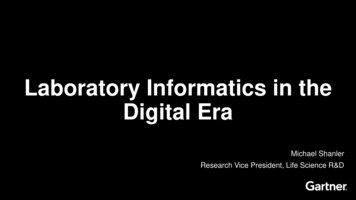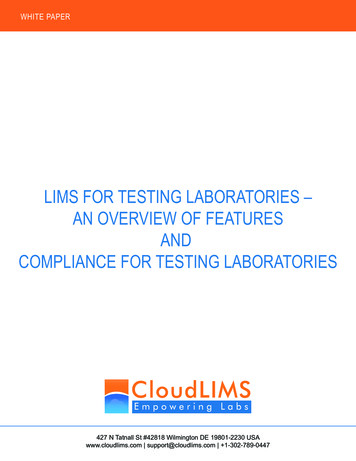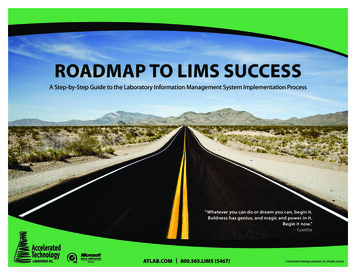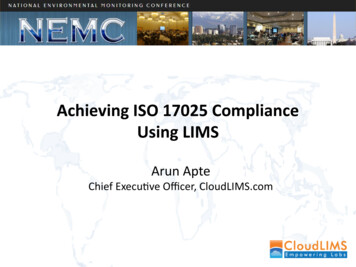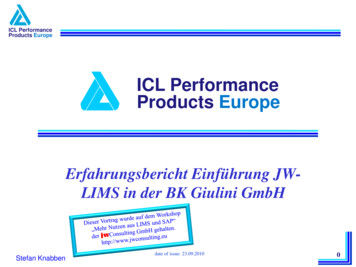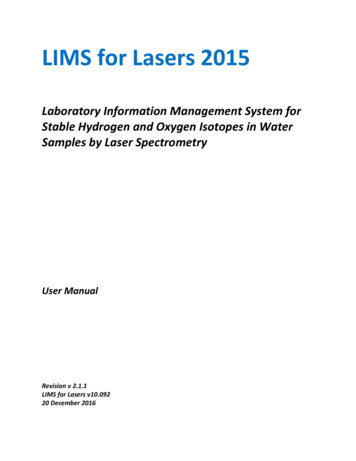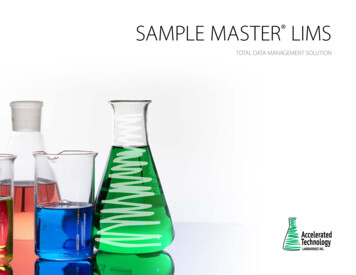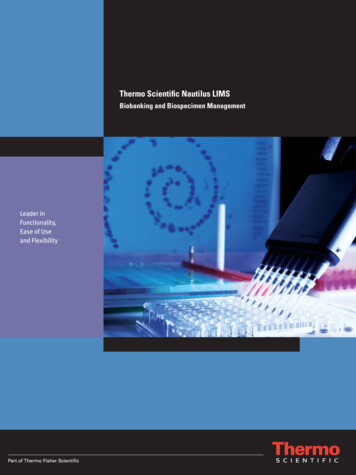
Transcription
LABORATORY INFORMATION MANAGEMENT SYSTEMS (LIMS):RE-ENGINEERING THE WAY SOUTH AFRICAN TESTING LABORATORIESCONDUCT BUSINESSSpeaker/Authour: D. NaickerCo-authour: V NaickerUniversity of South AfricaDharmarainaicker@gmail.comPhone: 082 042 8405AbstractA critical objective of a LIMS is the integration of different systems and processes such as the receipt ofsamples, testing as per the customer’s requirements, generating results and certificates of analysis. Byconsolidating the work of laboratory technicians and speeding up these processes, LIMS can save time anddramatically improve the access of results to analysts and ultimately the customer. A study was conductedto assess the current implementation of LIMS in testing laboratories in South Africa, as part of the businessprocess re engineering of the life science industry using a mixed methodology approach. Of the 328laboratories that were requested to participate in the survey only 72 (22%) of the laboratories responded,with 66 (92%) agreeing to participate and 8% declining to participate further in the survey. Of the 72laboratories, 32 completed the questionnaire. The majority of these laboratories (24%) use LIMS for samplemanagement while 20% use LIMS for analyses with calculations, 19% for user reporting, 14% for workflowautomation, 11% for quality assurance and control and 36% for instrument connection. When investigatingthe status of LIMS service providers in the South African market and their strengths and weakness andopportunities for improvement, Lab Ware was the preferred vendor for 36% of the respondents. Cost wasmentioned as a weakness of some of the LIMS vendors by half of the respondents in the survey. Just underhalf of the respondents (46.7%) mentioned costly improvements as a weakness of the LIMS. In analyzingwhat laboratories thought about the future of LIMS, 58% indicated that they plan to implement LIMS in thecloud, 25% through mobile devices and 17% through tablets. The implementation of a LIMS will meet theobjectives of reduced lead times, automation, enhanced productivity, reliable and accurate data, electronicreporting, and integration with other systems such as ERP and CRM.
1.IntroductionWhy are Laboratory Information Management Systems (LIMS) becoming a catalyst for and the face ofreengineered laboratories today? Is it just a new fad where everything is put on an information system? IsLIMS a necessity for every life science organisation? The laboratory like other business environmentsdepends on and is supported by information technology to reengineer business processes. Technologicaladvances through automation in the laboratory, has warranted a need for automation of its informationmanagement together with reduced lead times, accurate certificates of analysis and easy access toinformation resources. The LIMS is about the way a laboratory monitors and manages the results generatedthat represents the laboratory’s product or service offering. The use of LIMS in combination withautomation of laboratory processes such as the use of automated instruments, technological advances in theinstrumentation used, and environmental monitoring, has improved the efficiency and quality of the work byreducing the potential for human errors, increasing the throughput of testing and results generated andensuring that sample tracking processes that are otherwise complicated to perform without error by hand,are achieved[1].Changes in information management processes with the introduction of systems such as LIMS can createanxiety amongst the laboratory analysts and technicians because they have to adopt and implement newways of conducting business. These changes are costly, requiring manual and automated systems to be runin parallel in the beginning of the implementation and is often not easily acceptable to those who are directlyinvolved in operating the system. The long-term benefit however is enhanced effectiveness and efficiencywhich outweighs the initial outlay. A laboratory must be committed to allocate the necessary time andresources to plan, select, and implement a LIMS [2]. The system must however also be implemented in linewith the strategic objectives of the organisation.In the last 10 years, implementation of automated information management systems aimed to meet therequirements of faster turnaround times, reduced human errors and improved efficiency and effectivenesshas compelled organisations to face the challenge and embrace the opportunities of transforming the waythey conduct business [2] with LIMS being viewed as a catalyst for re engineering laboratory operations.This study proposes to survey and evaluate the impact re engineering of South African Testing Laboratory’swith LIMS has made on productivity, efficiency and effectiveness of the business. The study furtherproposes to present a framework for successful implementation of a LIMS as part of the re-engineering oflaboratory operational processes and continual improvement in the South African Testing Laboratorylandscape.Apart from providing an end to end integration of the laboratory within and across the organizationalfunctions, a LIMS helps increase efficiency and assigns ownership of activities, it helps improve the speed
and accuracy of the workflow process and helps disseminate information faster and accurately to the rightanalyst and can be used to gain a competitive advantage by customizing the system to reflect and amplifythe core competencies which are unique to a particular laboratory and its operating process.Real, tangible benefit is derived by developing improved products and services and by reducing costs. Thisrequires changes which involve the re-engineering or significant improvement of core business processes. ALIMS can allow these changes to be adopted, but the identification, design and implementation of them is apeople orientated process. A LIMS project is much more than specifying the requirements, selecting apackage and validating it. The people, business and change management issues all require equalconsideration, since these aspects of the project significantly affect the benefit delivered (Broad, 2010).Having implemented a LIMS in the laboratory the researcher also argues for the proper training of staff andtheir buy in, which is critical to the success of LIMS implementation.1.1 Redesigning the Business processes in LaboratoriesBusiness process redesign (BPR) is about creating innovative business processes which an organisation canimplement to meet the demands of today's information-intensive, global business marketplace. Themotivation is usually the realization that processes need to be completed faster with less resources toimprove productivity, efficiency and competitiveness [3].With the economic environment constantly changing, many organisations are increasing their interest inBPR. A study showed that approximately 87% of organisations questioned were either involved in or wereintending to implement BPR projects in the future [3]. The BPR process involves investing in manyprocesses to implement activities that produce a service or product offering that is valued by a customer.Process redesign is a programme that can have positive outcomes for change in an organization. When thecritical processes are redesigned correctly, BPR has the ability to improve company-wide performance. Inorder for laboratories in South Africa to be recognized as official testing laboratories by Government, theymust be ISO 17025 accredited, and involves continual improvements and redesigned processes.Information technology (IT) has the potential to give businesses options to redesign processes to develophigh-performing organizations. Today organisations are encouraged to adopt high performance cultures. Ahigh performance work culture is where innovation, performance, value-added change and customersatisfaction is valued by all employees and where the team is goal orientated, disciplined and focuses onimproving individual, team and organizational performance.Computers and information management technologies have evolved with time and are touching our liveswhere we live, play and work. Those of us who work in a laboratory environment are faced with thechallenge of how to best apply these information technologies to increase the revenue of the life scienceorganisations we work for to continually improve quality. While creating a culture of quality is a complex,
time consuming and expensive process, a LIMS helps to create a culture that values quality by ensuring dataintegrity and therefore becomes an essential need of the current business environment of the life scienceindustry in South Africa.1.2 The need for LIMS in the current business environment of the life sciences industryExecutive and Laboratory Management, and IT professionals often pose the question as to whether theyneed a LIMS.The LIMS has been recognized as a crucial function in the life sciences environment.Scientific and laboratory testing oriented companies are making major investments in their LIMS solutionsto improve productivity and data quality. With mandates to minimize costs while improving safety levelsand the quality of their findings, life science organizations are feeling the pressure[4]. One of the majorweaknesses of life science organisations is the inability to adapt quickly enough and change the largeamount of laboratory information into something meaningful to allow laboratory management to maketimely and appropriate business decisions[5].Currently there are companies that still use manual processes for collecting, analysing and reporting whichoften involves collating volumes of data taking the scientists away from the bench[5]. Companies that do notintegrate data sources across the business run the risk of transcribing data very slowly which is labourintensive and prone to errors. When employees utilize most of their time analysing data they cannot focus onbeing productive, which leads to loss of valuable employee time and income [5].As laboratories expand they face the challenge of processing data accurately and quickly and at the sametime keep an eye on the competition by making sure they stay ahead by using advanced technologies toimprove performance and profits [6]. One area where this is achieved is in the tracking of processes. Havinga good understanding of what happens at each step in the value chain, which employee is responsible foreach step, and what resources are involved can be helpful in addressing troubleshooting.Incorporatingchecks at critical control points is a good way to prevent bottlenecks along each step. Competency training,instrument validation, performance monitoring and sample tracking, are examples of some of the processesthat should be tracked to contribute to the optimal workflow process in the laboratory.One of the critical uses of a LIMS is to maintain proper records of samples and the tests required out onthem. This occurs at the point of sample receipt in the laboratory and often in a designated sample receivingarea that is well controlled. This sample management process assigns sample numbers or bar codes andrecords details of the sender, condition of samples, types of tests required, the type of matrix received,amongst other information as defined by the laboratory.Not only does a LIMS support green initiatives of reducing the extensive paper trail, it ensures the control ofa sample from receipt to the dissemination of a final result to a customer in the shortest time possible. Theresearcher has observed that in the business unit she manages with a customer base of over 500 clients inSouth Africa and abroad, the demand of customers is a lead time of 24-48hrs. LIMS is one of the ways the
laboratory has redesigned its workflow process to meet this objective of a reduced turnaround time. For alaboratory that performs a statutory function, testing for a specific market or industry, invaluable data isgenerated that is disseminated to that industry or government so that that may gauge the status of the qualityof that product in South Africa. Therefore in understanding the fundamentals of a LIMS, the power of thisinformation management tool can be evaluated for use by laboratories.1.3 The fundamentals of a LIMSThe LIMS is a software-based laboratory information management system that provides applications tosupport a laboratory's internal and external business processes.Figure.1. A light-hearted illustration to depict the evolution of a LIMS [7].With the emergence of LIMS in the 1980s assigning laboratory functions to a centralized computer,productivity and functionality improved. As technology advances and work flow changes, the need forapplication specific features emerged [7]. This initiated the development of second generation LIMS whichwas possible by using third-party commercial relational databases through the use of minicomputers and bythe early 1990s the first client/server configuration was developed using a PC combined with the security ofa minicomputer [7]. Functionality “appeared” quicker by splitting the data processing between severalclients and the main database server. Fourth generation LIMS was developed by the mid-1990s whichallows distributing client/server functions over a network to optimise processing and sharing capabilities andin 1996, the internet advanced and initiated the first web-enabled and wireless computing features for LIMS[7]. Now a LIMS is packed with full functionality for laboratories to immediately benefit from increasedproductivity after implementation.These characteristics of a LIMS have improved over time from simple sample tracking to an enterpriseresource planning tool that manages multiple facets of laboratory informatics [8].LIMS productshave been growing beyond their original intention of sample management to include data management,mining , and analysis, and electronic laboratory notebook (ELN) integration [8].
Figure 2. A schematic illustration of a typical LIMS integrated into the sample receipt, analysis andgeneration of certificates of analysis for the client. [9].LIMS offer an increasing amount of integration with laboratory instruments and applications (Figure 2).The increase in data being generated in laboratories and business demands with profitability beingprioritised, LIMS suppliers have to focus on how the LIMS they offer can manage data exchanges, on howan instrument's input and output data is managed, how remote sample collection data is imported andexported, and how mobile technology integrates with the LIMS [10].1.4 The importance of this studyIt has become evident through the years that accuracy and turnaround times in a laboratory are critical to itscredibility and are key value propositions to give it a competitive edge. Customers are prepared to paypremium for an accurate and reliable service. The LIMS is an effective way to allow for validation of datacaptured detecting errors. The ISO 17025 accreditation or quality assurance process of each laboratoryallows for improvement in the quality and reliability of data generated. LIMS can be a useful tool that couldgive a laboratory its value proposition over other laboratories, saving time and money. Laboratories workdifferently and design their processes to meet their needs therefore a LIMS must be aligned to the laboratoryworkflow and must be able to address future improvements in laboratory’s internal business processes. ALIMS implementation involves the evaluation, monitoring and modification to ensure improved laboratoryprocesses. Having reviewed the relevant literature, it is clear that finding the right LIMS to meet the specificneeds of laboratories is critical in order for the successful implementation.
As technology advances, South Africa needs to keep up in order to compete in global markets. Life Scienceorganisations are under pressure to redesign their laboratory testing processes to comply to internationalstandards in order to penetrate EU markets. From the researchers own experience of an EU audit of alaboratory that is an assignee of the Department of Agriculture, Fisheries and Forestry, one of their findingsreported to the international community three years ago, was the absence of a LIMS in the statutorylaboratory. Therefore the implementation of a LIMS as part of the redesign efforts will hold South Africantesting laboratories in good stead. South Africa’s long term investments in agricultural science andtechnology will facilitate future competitiveness of the commercial sector and ensure sustained marketaccess. The bio-economy strategy (the “Farmer to Pharma Value Chain”), National Development Plan,Food Security Policy framework and the Food Security Implementation Plan provide the roadmap for futureeconomic growth, national food security and international trade. Life science organizations are cognizant ofthese developments, and need to be assertive in its approach, and be forward looking by redesigningbusiness processes and position themselves against this background.2.MethodologyA mixed method research approach was adopted in this study using primary and secondary data and aquestionnaire posed to the listed accredited testing laboratories on the SANAS database to explore theimplementation of the LIMS in South African testing laboratories. A framework for successfulimplementation of LIMS that could be used by testing laboratories in business process re-engineering toimprove productivity and efficiencies was then formulated.3.Results and DiscussionThe study focused on the categories of customization, vendor service, staff use and customer satisfaction ofLIMS.With respect to the demographics of the participants that responded, 62% of the laboratories arebased in Gauteng, 14% in Kwazulu Natal and 7% from the Western Cape. No laboratories from theNorthern Cape participated in the survey.Of the laboratories that responded to the survey 58% of the laboratories have a LIMS in place, 30% are notplanning to implement a LIMS, and while 12% indicated that they plan to implement a LIMS in the future.Every organization has its own barriers that may prevent it from implementing a LIMS from costs, toorganisational priorities and strategies. It is recommended that a proper needs analysis be conducted bylaboratories, including research on the LIMS and its benefits and weaknesses before deciding if a LIMS willbe worth the investment and fit for purpose. In some instances external stakeholders demand that thelaboratory have a LIMS in place which leaves the laboratory with no choice.The majority of the laboratories (24%) that responded use LIMS for sample management while 20% useLIMS for analyses with calculations, 19% for user reporting, 14% for workflow automation, 11% for qualityassurance and control and 10% for instrument connection. With respect to instrument interfacing with
LIMS only 50% of the laboratories that responded have integrated instruments to LIMS. One area ofconcern is the perception that the process of linking systems is complex. Integration requires support fromthe vendor, but is encouraged by the author because it reduces the chances of errors and the time taken togenerate the certificate of analysis, having a positive impact on productivity and efficiencies in thelaboratory.In addressing the objective of evaluating the preferred LIMS vendor service providers Lab Ware was thepreferred vendor for the majority of respondents. Cost was mentioned as a weakness of some of the LIMSvendors by half of the respondents.Costly improvements, a lack of technical support and costlymaintenance plans of their vendors were further drawbacks of the systems. LIMS projects require time, topmanagement support and money.It is recommended that the motivation to purchase a LIMS must be made in the context of affordability, fitfor purpose, productivity and efficiency. The laboratory management team must do needs analysis, presentprojections of returns on investment both tangible and intangible and present a proper business plan for theselection, implementation and evaluation of the LIMS to Executive Management. This would also ensurebuy in by the team and reassure them that business processes are re engineered to improved productivity andnot make analysts redundant.To ensure that costs are contained, a budget for implementation for LIMS must be approved by TopManagement timeously (a year in advance is preferable).Requesting an unbudgeted approval frommanagement may create the impression of poor planning and lack of confidence by Top Management thatthe investment could result in returns.The two most important decision making factors for the respondents in choice of a vendor were service andsupport, and customization.Every laboratory has its own workflow processes, different types ofinstruments for system integration, different formats of certificate of analysis, varying throughput per dayand different levels of competencies with respect to information technology and management.Customization is critical for the success of implementation of a LIMS.It is recommended that theorganisation pay for a monthly maintenance plan to ensure upgrades are made without additional costs, butmore importantly a service level agreement should be in place to ensure that the vendor continues to provideafter sales support.The faster turnaround times and easy access to data were the benefits that most of the respondentsexperienced with LIMS implementation in their laboratories. Many customers rely on a fast turnaround timeand are often prepared to pay premium for same day results from laboratories. A laboratory that offers thisservice will be able to attract more business.Respondents were also confident to refer LIMS to otherorganisations, based on their own experiences of the information system in their environments. The authorrecommends that laboratories profile their implementation of LIMS on their websites, through workshops
and conferences, because a LIMS is also viewed as a paperless tool and a ‘green’ initiative which cancontribute to the corporate social responsibility (CSR) of the organisation.The author reviewed the literature on the basic requirements for selection and implementation andformulated a framework making recommendations along each step (Fig 3). By following the six steps ofproject definition, functional requirements, functional design, implementation, system integration andsystem evaluation, it is envisaged that laboratories will be able to implement a LIMS that will meet theobjectives of faster turnaround times, automation, increased productivity, higher quality of data, electronicreporting, and integration with other enterprise databases.4.ConclusionThis study proposed to survey and evaluate the impact re engineering of South African Testing Laboratory’swith LIMS has made on productivity, efficiency and effectiveness of the business. Through the onlinesurvey of SANAS accredited testing laboratories in South Africa, the study attempted to assess the currentimplementation of LIMS in testing laboratories as part of the business process re engineering of the lifescience industry. The study further proposed to present a framework for successful implementation of aLIMS as part of the re-engineering of laboratory operational processes and continual improvement in theSouth African Testing Laboratory landscape. By determining the impact of LIMS on sustainability,profitability and efficiencies the study aimed to provide guidance to laboratories considering the adoption ofthis informatics system to improve accuracy, reliability and validity of laboratory testing results, especiallywhen decisions on human and animal health are impacted by speedy and accurate results obtained fromthese facilities.In the South African laboratory testing environment, LIMS is emerging as a tool to implement automationof data and information. South African laboratories that have responded to the survey have embraced thetechnology, acknowledged its strategic benefits in improving productivity, efficiency and effectiveness andare looking to continually improve the system to service its customers with reliable, valid and accurateresults.
Phase 1Phase 2Phase 3Phase 4Phase 5A Needs AnalysisDefining the projectThedecisiontoimplement a LIMS in alaboratory is influencedby the strategic goals ofthe organisation.Describe the objectivesto be achieved, bywhom, by when andwhy.Identifying resourcerequirements & systemspecificationFunctional andimplementationdesignsSystem integration andevaluationPresent a detailed andcomprehensive dsystem specificationsEngage all potentialusers of the system toreduce or eliminateresistance to change.Decide on the feasibilitydeterminations such asofftheshelforcustomizedsystems,instrument rceneeds and conduct ananalysis, determine thetype of LIMS that is fitfor purpose.This step also includesputting together theteamsneededforproject implementationandsignoffbycommitted individuals.This step also includesa functional documentthat is used as thebasis for the request forproposalsenttopotential LIMS vendorsduring the procurementprocess.Before the decision ismade by organisationsto buy a LIMS, thelaboratory must haveanindepthunderstanding of itsworkflowprocesses,how it wants to improvethese processes andhow a system like LIMSwill assist it in attainingitsstrategicandoperational objectives.Commitment from theexecutive is critical.They must ensure thatfinancialandstaffresources are availabletoimplementthesystem. The projectsponsor should be theCEO or a member ofthe Board. The Projectowner should be theLaboratoryManagerandtheprojectmanager should be thelaboratory supervisor orthe quality manager.Some of the selectioncriteria include: vendorselection,portability,customisation, safety,security and reliabilityspecification,maintenance plans &theimplementationprocess.LIMS vendors can besourced through theannual LAB AFRICAExpo,where manyvendors profile be the LIMS anddetailhowthefunctional requirementsare to be met. It isdefinedbyflowdiagrams of informationflowthroughtheworkflow processes.The laboratory mustensure that it allocatessufficient resources.AproperlybudgetedLIMSshouldbeincluded in the budgetforthefollowingfinancial year, with allthe motivations andapprovals in place fortimely procurement andimplementation.It also involves theselection of type ofLIMSandvendor.Implement a a workprocess evaluation, apurchase plan and avendor audit.Figure 3. A proposed framework for a LIMS selection and implementationInvolves acquiring alltherequiredcomponents, interfacingthe system components,software installation andthen‘going live’.Serviceprovidertoprovide in depth trainingtothedesignatedsystems administratorand the quality managerwhowilltransferknowledge to the otheridentified analysts.Also involves revisitingthe project definition andfunctional requirementsand comparing it to thefinal system to assesshow well the needswere met.It is recommended thataperformanceandmonitoringplanbeimplemented (BSC) andthe ROI be measuredand presented to theTop Management.
References1. Voegele, C., Tavtigian, S.V., de Silva, D., Cuber, S., Thomas, A., Le Calvez-Kelm,F.2007. ‘A Laboratory Information Management System (LIMS) for a highthroughput genetic platform aimed at candidate gene mutation screening’,Bioinformatics, 23(18): 2504-25062. Avery, G., McGee, C. & Falk, S. 2000. ‘ Implementing LIMS : A How to Guide’,Analytical Chemistry, A: 57-62.3. Attaran, M. 2004. ‘Exploring the relationship between information technology andbusiness process reengineering’, Information & Management ,41:585–5964. Nogueira, A., Chawla, V., Lau, K., Eastman, J. 2014.’ Industry outlook: LIMSMaster Data Management in the Life Sciences industry, IGate White Paper5. Shah, K. 2009.‘Elevating laboratory informatics to assist decision making’,PharmTech.com, 21(5).6. Paszko, C., Pugsley, C. 2000. ‘Consideration in selecting a laboratory informationmanagement system (LIMS)’, Accelerated Technology Laboratories, September.7. Webster, T. 2013.The Evolution of LIMS [online].Available ution-of-lims [Accessed 19 June2015].8. Roebuck, K.2013.LIMS Laboratory Information Management System:Highimpact strategies –what you need to know: definitions, adoptions, Impact, benefits,maturity, vendors. Emereo Publishing.9. 02/image preview [Accessed 19 April 2015].10. How Do I Find the Right LIMS — And How Much Will It Cost? 2011. LaboratoryInformatics Institute, Inc.
The LIMS is a software-based laboratory information management system that provides applications to support a laboratory's internal and external business processes. Figure.1. A light-hearted illustration to depict the evolution of a LIMS [7]. With the emergence of LIMS in the 1980s assigning laboratory functions to a centralized computer, .
